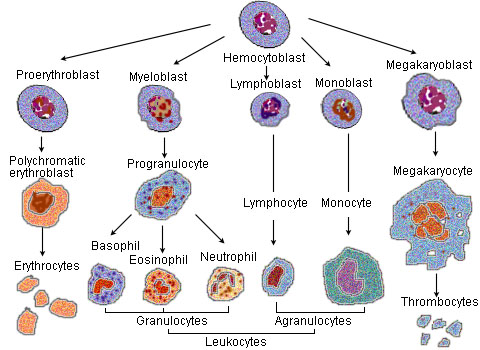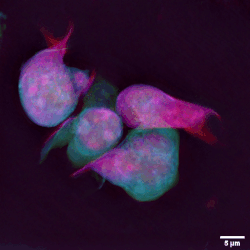|
PU.1
Transcription factor PU.1 is a protein that in humans is encoded by the ''SPI1'' gene. Function This gene encodes an ETS-domain transcription factor that activates gene expression during myeloid and B-lymphoid cell development. The nuclear protein binds to a purine-rich sequence known as the PU-box found on enhancers of target genes, and regulates their expression in coordination with other transcription factors and cofactors. The protein can also regulate alternative splicing of target genes. Multiple transcript variants encoding different isoforms have been found for this gene. The PU.1 transcription factor is essential for hematopoiesis and cell fate decisions. PU.1 can physically interact with a variety of regulatory factors like SWI/SNF, TFIID, GATA-2, GATA-1 and c-Jun. The protein-protein interactions between these factors can regulate PU.1-dependent cell fate decisions. PU.1 can modulate the expression of 3000 genes in hematopoietic cells including cytokines. It is ... [...More Info...] [...Related Items...] OR: [Wikipedia] [Google] [Baidu] |
IRF4
Interferon regulatory factor 4 (IRF4) also known as MUM1 is a protein that in humans is encoded by the ''IRF4'' gene. IRF4 functions as a key regulatory transcription factor in the development of human immune cells.Nam S, Lim J-S (2016). "Essential role of interferon regulatory factor 4 (IRF4) in immune cell development." ''Arch. Pharm. Res''. 39: 1548–1555doi:10.1007/s12272-016-0854-1Shaffer AL, Tolga Emre NC, Romesser PB, Staudt LM (2009). "IRF4: Immunity. Malignancy! Therapy?" ''Clinical Cancer Research''. 15 (9): 2954-2961doi:10.1158/1078-0432.CCR-08-1845/ref> The expression of IRF4 is essential for the differentiation of T lymphocytes and B lymphocytes as well as certain myeloid cells. Dysregulation of the ''IRF4'' gene can result in ''IRF4'' functioning either as an oncogene or a tumor-suppressor, depending on the context of the modification. The ''MUM1'' symbol is also the current HGNC official symbol for melanoma associated antigen (mutated) 1 (HGNC:29641). Immune ce ... [...More Info...] [...Related Items...] OR: [Wikipedia] [Google] [Baidu] |
Haematopoiesis
Haematopoiesis (; ; also hematopoiesis in American English, sometimes h(a)emopoiesis) is the formation of blood cellular components. All cellular blood components are derived from haematopoietic stem cells. In a healthy adult human, roughly ten billion () to a hundred billion () new blood cells are produced per day, in order to maintain steady state levels in the peripheral circulation.Semester 4 medical lectures at Uppsala University 2008 by Leif Jansson Process Haematopoietic stem cells (HSCs) Haematopoietic stem cells (HSCs) reside in the medulla of the bone ( bone marrow) and have the unique ability to give rise to all of the different mature blood cell types and tissues. HSCs are self-renewing cells: when they differentiate, at least some of their daughter cells remain as HSCs so the pool of stem cells is not depleted. This phenomenon is called asymmetric division. The other daughters of HSCs ( myeloid and lymphoid progenitor cells) can follow any of the other diff ... [...More Info...] [...Related Items...] OR: [Wikipedia] [Google] [Baidu] |
FUS (gene)
RNA-binding protein fused in sarcoma/translocated in liposarcoma (FUS/TLS), also known as heterogeneous nuclear ribonucleoprotein P2 is a protein that in humans is encoded by the ''FUS'' gene. Discovery FUS/TLS was initially identified as a fusion protein (FUS-CHOP) produced as a result of chromosomal translocations in human cancers, especially liposarcomas. In these instances, the promoter and N-terminal part of FUS/TLS is translocated to the C-terminal domain of various DNA-binding transcription factors (e.g. C/EBP homologous protein, CHOP) conferring a strong transcriptional activation domain onto the fusion proteins. FUS/TLS was independently identified as the hnRNP P2 protein, a subunit of a complex involved in the maturation of pre-mRNA. Structure FUS/TLS is a member of the FET protein family that also includes the Ewing sarcoma breakpoint region 1, EWS protein, the TATA-binding protein TBP-associated factor TAFII68/TAF15, and the Drosophila cabeza/SARF protein. FUS/T ... [...More Info...] [...Related Items...] OR: [Wikipedia] [Google] [Baidu] |
GATA2
GATA2 or GATA-binding factor 2 is a transcription factor, i.e. a nuclear protein which regulates the expression of genes. It regulates many genes that are critical for the embryonic development, self-renewal, maintenance, and functionality of blood-forming, lymphatic system-forming, and other tissue-forming stem cells. GATA2 is encoded by the ''GATA2'' gene, a gene which often suffers germline and somatic mutations which lead to a wide range of familial and sporadic diseases, respectively. The gene and its product are targets for the treatment of these diseases. Inactivating mutations of the ''GATA2'' gene cause a reduction in the cellular levels of GATA2 and the development of a wide range of familial hematological, immunological, lymphatic, and/or other disorders that are grouped together into a common disease termed GATA2 deficiency. Less commonly, these disorders are associated with non-familial (i.e. sporadic or acquired) ''GATA'' inactivating mutations. GATA2 deficien ... [...More Info...] [...Related Items...] OR: [Wikipedia] [Google] [Baidu] |
SWI/SNF
In molecular biology, SWI/SNF (SWItch/Sucrose Non-Fermentable), is a subfamily of ATP-dependent chromatin remodeling complexes, which is found in eukaryotes. In other words, it is a group of proteins that associate to remodel the way DNA is packaged. This complex is composed of several proteins – products of the SWI and SNF genes (, /, , , ), as well as other polypeptides. It possesses a DNA-stimulated ATPase activity that can destabilize histone-DNA interactions in reconstituted nucleosomes in an Adenosine triphosphate, ATP-dependent manner, though the exact nature of this structural change is unknown. The SWI/SNF subfamily provides crucial nucleosome rearrangement, which is seen as ejection and/or sliding. The movement of nucleosomes provides easier access to the chromatin, enabling binding of specific transcription factors, and allowing genes to be activated or repressed. The human analogs of SWI/SNF are "SMARCA4, BRG1- or SMARCA2, BRM-associated factors", or BAF (SWI/SNF-A) ... [...More Info...] [...Related Items...] OR: [Wikipedia] [Google] [Baidu] |
GATA1
GATA-binding factor 1 or GATA-1 (also termed Erythroid transcription factor) is the founding member of the GATA family of transcription factors. This protein is widely expressed throughout vertebrate species. In humans and mice, it is encoded by the ''GATA1'' and ''Gata1'' genes, respectively. These genes are located on the X chromosome in both species. GATA1 regulates the expression (i.e. formation of the genes' products) of an ensemble of genes that mediate the development of red blood cells and platelets. Its critical roles in red blood cell formation include promoting the maturation of precursor cells, e.g. erythroblasts, to red blood cells and stimulating these cells to erect their cytoskeleton and biosynthesize their oxygen-carrying components viz., hemoglobin and heme. GATA1 plays a similarly critical role in the maturation of blood platelets from megakaryoblasts, promegakaryocytes, and megakaryocytes; the latter cells then shed membrane-enclosed fragments of their c ... [...More Info...] [...Related Items...] OR: [Wikipedia] [Google] [Baidu] |
T Cell
T cells (also known as T lymphocytes) are an important part of the immune system and play a central role in the adaptive immune response. T cells can be distinguished from other lymphocytes by the presence of a T-cell receptor (TCR) on their cell surface receptor, cell surface. T cells are born from hematopoietic stem cells, found in the bone marrow. Developing T cells then migrate to the thymus gland to develop (or mature). T cells derive their name from the thymus. After migration to the thymus, the precursor cells mature into several distinct types of T cells. T cell differentiation also continues after they have left the thymus. Groups of specific, differentiated T cell subtypes have a variety of important functions in controlling and shaping the immune response. One of these functions is immune-mediated cell death, and it is carried out by two major subtypes: Cytotoxic T cell, CD8+ "killer" (cytotoxic) and T helper cell, CD4+ "helper" T cells. (These are named for the presen ... [...More Info...] [...Related Items...] OR: [Wikipedia] [Google] [Baidu] |
Protein
Proteins are large biomolecules and macromolecules that comprise one or more long chains of amino acid residue (biochemistry), residues. Proteins perform a vast array of functions within organisms, including Enzyme catalysis, catalysing metabolic reactions, DNA replication, Cell signaling, responding to stimuli, providing Cytoskeleton, structure to cells and Fibrous protein, organisms, and Intracellular transport, transporting molecules from one location to another. Proteins differ from one another primarily in their sequence of amino acids, which is dictated by the Nucleic acid sequence, nucleotide sequence of their genes, and which usually results in protein folding into a specific Protein structure, 3D structure that determines its activity. A linear chain of amino acid residues is called a polypeptide. A protein contains at least one long polypeptide. Short polypeptides, containing less than 20–30 residues, are rarely considered to be proteins and are commonly called pep ... [...More Info...] [...Related Items...] OR: [Wikipedia] [Google] [Baidu] |
Megakaryocyte
A megakaryocyte () is a large bone marrow cell with a lobation, lobated nucleus that produces blood platelets (thrombocytes), which are necessary for normal blood coagulation, clotting. In humans, megakaryocytes usually account for 1 out of 10,000 bone marrow cells, but can increase in number nearly 10-fold during the course of certain diseases. Owing to variations in neoclassical compound, combining forms and spelling, synonyms include megalokaryocyte and megacaryocyte. Structure In general, megakaryocytes are 10 to 15 times larger than a typical red blood cell, averaging 50–100 μm in diameter. During its maturation, the megakaryocyte grows in size and replicates its DNA without cytokinesis in a process called mitosis#Errors and other variations, endomitosis. As a result, the nucleus of the megakaryocyte can become very large and lobulated, which, under a light microscope, can give the false impression that there are several nuclei. In some cases, the nucleus may contain up to ... [...More Info...] [...Related Items...] OR: [Wikipedia] [Google] [Baidu] |
Lymphocyte
A lymphocyte is a type of white blood cell (leukocyte) in the immune system of most vertebrates. Lymphocytes include T cells (for cell-mediated and cytotoxic adaptive immunity), B cells (for humoral, antibody-driven adaptive immunity), and innate lymphoid cells (ILCs; "innate T cell-like" cells involved in mucosal immunity and homeostasis), of which natural killer cells are an important subtype (which functions in cell-mediated, cytotoxic innate immunity). They are the main type of cell found in lymph, which prompted the name "lymphocyte" (with ''cyte'' meaning cell). Lymphocytes make up between 18% and 42% of circulating white blood cells. Types The three major types of lymphocyte are T cells, B cells and natural killer (NK) cells. They can also be classified as small lymphocytes and large lymphocytes based on their size and appearance. Lymphocytes can be identified by their large nucleus. T cells and B cells T cells (thymus cells) and B cells ( bone marrow- ... [...More Info...] [...Related Items...] OR: [Wikipedia] [Google] [Baidu] |
Inflammation
Inflammation (from ) is part of the biological response of body tissues to harmful stimuli, such as pathogens, damaged cells, or irritants. The five cardinal signs are heat, pain, redness, swelling, and loss of function (Latin ''calor'', ''dolor'', ''rubor'', ''tumor'', and ''functio laesa''). Inflammation is a generic response, and therefore is considered a mechanism of innate immunity, whereas adaptive immunity is specific to each pathogen. Inflammation is a protective response involving immune cells, blood vessels, and molecular mediators. The function of inflammation is to eliminate the initial cause of cell injury, clear out damaged cells and tissues, and initiate tissue repair. Too little inflammation could lead to progressive tissue destruction by the harmful stimulus (e.g. bacteria) and compromise the survival of the organism. However inflammation can also have negative effects. Too much inflammation, in the form of chronic inflammation, is associated with variou ... [...More Info...] [...Related Items...] OR: [Wikipedia] [Google] [Baidu] |




